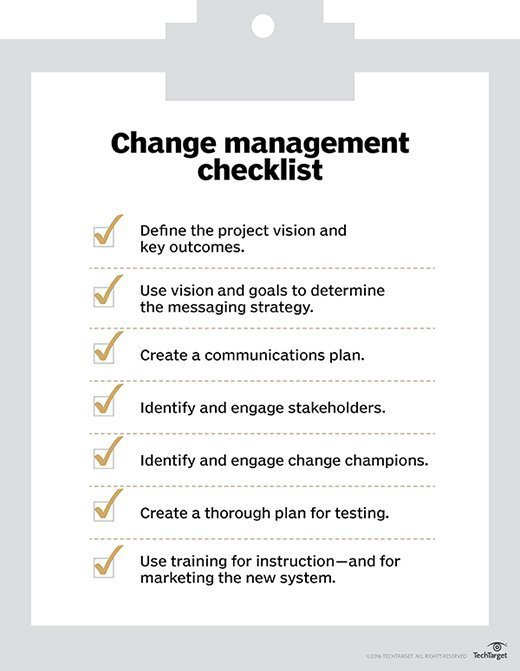
twixx - Fotolia
Avoid implementation failure with an effective change management plan
Employees may see only the negatives in new technology or processes -- changes to their workflow, lost productivity and so on. That's why change management is so crucial.
Change management -- and more specifically, a change management plan -- is a critical component to ensuring new technology success in an enterprise. No matter whether you are implementing a new human capital management system, finance system or replacement materials management system, or rolling out a new mobile strategy, an effective change management plan enables you to successfully communicate your new processes and facilitate user adoption.
How do you know whether you need a change management plan? Here's a rule of thumb: Whenever you want to roll out changes to a business process or supporting technology, you need one.
Essentials to creating a change management plan
There are several key elements to building out an effective change management plan to support new enterprise technology and processes. Here are some essentials.
- Define the project vision and key outcomes. How do you intend the project to affect your organization? What organizational and behavioral changes should it influence? How should it influence profitability? What will count as success factors?
- Use the project vision and outcomes to determine a messaging strategy. The project vision and key outcomes will be useful for determining your communications plan, but it is imperative to truly consider your employees and how they will view the new technology and processes. The message should appeal to employees' concerns.
- Create a communications plan. Decide on communication types, frequency, schedule and target audience. Email blasts, posters, paraphernalia, status updates, kick off sessions and so on -- which communication type is most appropriate for each message? How often will messages be pushed out? To whom?
- Identify and engage stakeholders. Stakeholders are the individuals who own the success of the project and, therefore, the success of the change management plan. They will influence and help to drive the technology success, and, thus, must to be engaged early on and be kept abreast of the change management plan's progress.
- Identify and engage change champions. Change champions are the individuals around your business who will promote the new enterprise technology and supporting processes. Their role is to influence the interest and excitement of other employees about the project, so they are typically role models who are trusted by management as well as their co-workers. They also are typically good at networking and skilled at influencing and engaging co-workers.
- Create a thorough plan for testing. A good testing strategy is key to adoption. Besides defining the right testing for the right phase of the project, testing is an opportunity to get employees' hands-on access to the new technology and get them excited about what it will do.
- Use training for instruction -- and for marketing. Employees need to know how the new system works, but training from a change management perspective is also an opportunity to influence trainees on the benefits of the system and how it helps their everyday job.
The change management lead should coordinate these activities, but leverage the different stakeholders and functional leads, and project management office (PMO) to support them. The PMO should help the change management lead plan and schedule the activities required to deliver the change management plan.
The myriad challenges of change management
Change management ultimately drives user adoption of processes and the technology you are using to support those processes. In the long run, your technology strategy and the return on investment are dependent on this adoption. However, you shouldn't underestimate just how difficult change management is -- it requires a serious investment of time and resources, as well as a detailed plan and individuals who can execute that plan.
Change management has many facets, from stakeholder engagement to communications to the process of getting employees and managers to understand and embrace the change. Quite often, change can be seen by managers and employees as something that complicates processes or adds extra work to their workload. A winning change management plan will alleviate those concerns and lead stakeholders to support the new system and processes that are driving your change management plan.

Change management pitfalls and how to mitigate them
Many enterprise technology projects fail because of insufficient investment in change management. Employees don't see why a new process is being implemented, how it works or what the real benefits are. For most employees, the first time they know about a new process or system is the go-live announcement or a training that they must attend. This is not sufficient notice or communication for them to truly understand what is being done. However, there are some things you can do in order to mitigate the risks of change management failure.
- Plan ahead. Change management begins even before you kick off your project, and a change management lead should be assigned to run the change management stream from your side (your implementation partner may also provide a change management specialist).
- As with the above, engage your key stakeholders and identify your change champions early on.
- Prepare early communication about the project and what benefits it will bring.
- Document all process and organizational changes necessary from the early stages of the project. This will help to define a good communication strategy and ensure nothing falls through the cracks.
- Prepare regular communications that keep employees up-to-date and remind them how the new technology will help them.
- Engage champions and other employees in testing so they get can excited about the technology soon.
- If possible, identify the "opponents" of change and use testing as a way of changing their minds -- this can be an effective strategy to get other employees excited. Employees will often take the positive opinion of individuals who typically only speak negatively about new projects.
- Issue a detailed communication ahead of the training announcement.
- Ensure employees are well-trained prior to go live. (Sometimes this can be combined with the next point.)
- Run a roadshow or regional events where employees can find out more information. Giveaways are often useful tools to attract attention.
- Measure adoption from go live; identify your success criteria upfront and produce daily (or more frequent) statistics to ascertain how many people have been using the new technology system.
- Keep communications running for one or two months to ensure adoption.
Whatever new technology and processes you implement, change management is going to be vital in their adoption. Communication is key to helping employees understand what benefits the changes bring and ensuring employees have the knowledge to use the new system without relying on other resources.








